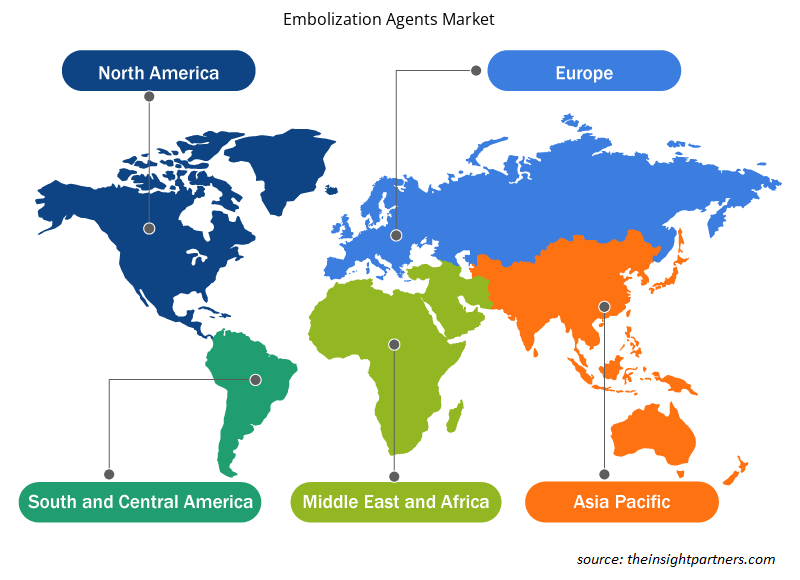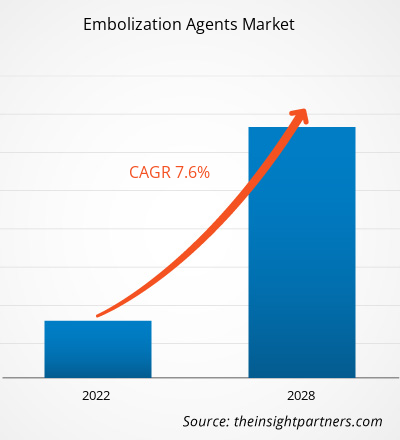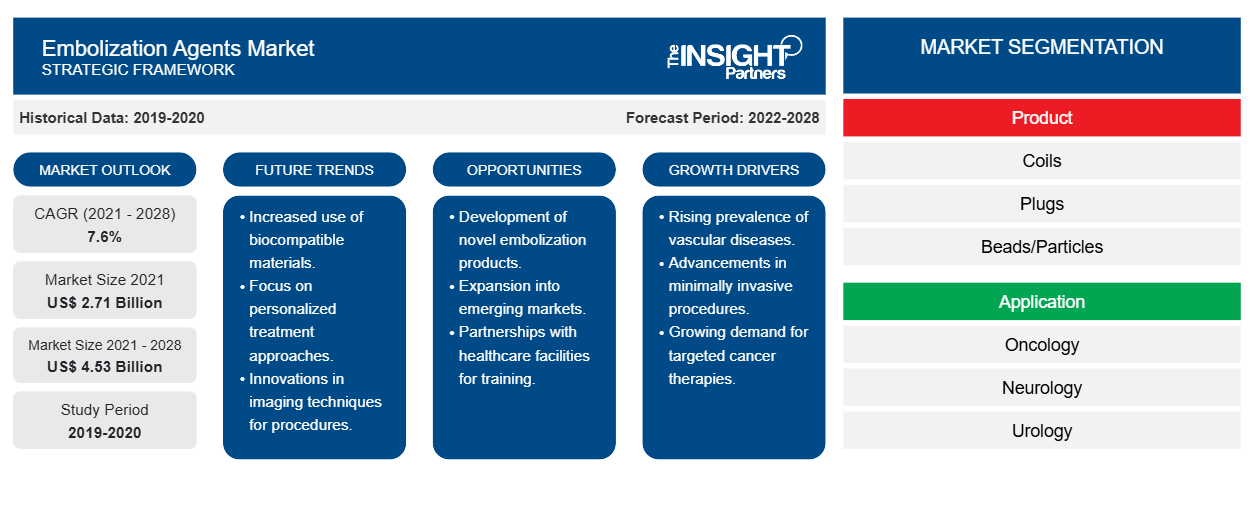Le marché des agents d'embolisation devrait atteindre 4 525,75 millions USD d'ici 2028, contre 2 714,82 millions USD en 2021 ; il devrait croître à un TCAC de 7,6 % de 2021 à 2028.
La croissance du marché est attribuée à l'incidence croissante des tumeurs et des anévrismes et à la prévalence croissante de l'hypertension, de l'obésité, du tabagisme et de l'alcoolisme. Cependant, les coûts élevés des agents d'embolisation freinent la croissance du marché des agents d'embolisation . Les agents d'embolisation sont utilisés pour appliquer une occlusion mécanique afin d'arrêter le flux sanguin dans un vaisseau sanguin ou une zone vasculaire. En radiologie interventionnelle, l'embolisation est une procédure courante. Les procédures d'embolisation sont principalement utilisées pour traiter les blessures traumatiques. Les agents emboliques se présentent sous diverses formes, chacune avec son propre ensemble de propriétés et d'applications. Selon la durée requise pour l'occlusion artérielle, les agents d'embolisation sont classés comme temporaires ou permanents.
Aux États-Unis, la demande de procédures de traitement des verrues a diminué en raison du changement d'orientation vers le traitement du COVID-19. La pandémie de COVID-19 a fait des ravages dans les chaînes d'approvisionnement, les marchés de consommation et les économies mondiales. Cette situation a entraîné une baisse des procédures cardiaques pratiquées dans divers pays d'Asie-Pacifique. Les mesures mises en œuvre par les gouvernements du monde entier ont eu un impact négatif sur la croissance du marché des agents d’embolisation.
Personnalisez ce rapport en fonction de vos besoins
Vous bénéficierez d'une personnalisation gratuite de n'importe quel rapport, y compris de certaines parties de ce rapport, d'une analyse au niveau des pays, d'un pack de données Excel, ainsi que de superbes offres et réductions pour les start-ups et les universités.
-
Obtenez les principales tendances clés du marché de ce rapport.Cet échantillon GRATUIT comprendra une analyse de données, allant des tendances du marché aux estimations et prévisions.
Perspectives du marché
L'incidence croissante des tumeurs et des anévrismes stimule la croissance du marché des agents d'embolisation
Selon le National Cancer Institute, en 2020, il y a eu 1 806 590 nouveaux cas de cancer et 606 520 décès dus à cette maladie aux États-Unis. En 2020, les cancers de la prostate, du poumon et colorectal représentaient 43 % de tous les cancers diagnostiqués chez les hommes. Les cancers du sein, du poumon et colorectal sont les trois cancers les plus fréquemment diagnostiqués chez les femmes. Selon le rapport de la Brain Aneurysm Foundation, Statistics and Facts, aux États-Unis, environ 6,5 millions de personnes, soit 1 personne sur 50, ont un anévrisme cérébral non rompu. Il a également mentionné que 20 % du total des personnes diagnostiquées avec un anévrisme cérébral ont plus d'un anévrisme. Il a en outre signalé que, chaque année, environ 30 000 personnes aux États-Unis souffrent d'une rupture d'anévrisme cérébral et qu'une rupture d'anévrisme cérébral se produit toutes les 18 minutes. De plus, selon le NHS, chaque année au Royaume-Uni, 1 personne sur 12 500 souffre d'un anévrisme cérébral rompu en Angleterre. De plus, selon le rapport « Pathogenèse et gestion individualisée des anévrismes intracrâniens non rompus » publié dans Deutsches Ärzteblatt International en 2020, environ 2 millions de personnes (adultes) en Allemagne souffrent d'un anévrisme intracrânien (AI) non rompu. Les agents d'embolisation sont utilisés pour arrêter de manière aiguë le flux dans un vaisseau sanguin ou un territoire vasculaire au moyen d'une occlusion mécanique. Les agents d'embolisation, tels que les microsphères emboliques (billes), sont utilisés pour restreindre l'apport vasculaire aux tumeurs et peuvent être chargés de médicaments chimiothérapeutiques, qui s'éluent et se diffusent dans les tissus. Les agents emboliques liquides sont utilisés pour empêcher l'apport sanguin à l'anévrisme ou à la tumeur. Ainsi, la prévalence croissante des anévrismes et des cancers crée une forte demande d'agents d'embolisation.
Informations basées sur les produits
En fonction du produit, le marché des agents d'embolisation est segmenté en bobines, billes/particules, bouchons, ballons détachables, colle, éponge, embolisants liquides, sclérosants, agents précipitants et autres. Le segment des billes/particules détient la plus grande part du marché. Cependant, le segment des bobines devrait enregistrer le TCAC le plus élevé au cours de la période 2021-2028. L'embolisation par bobine est une procédure basée sur un cathéter qui permet l'occlusion précise d'un flux sanguin anormal dans un vaisseau sanguin. Le nombre croissant d'interventions chirurgicales cardiaques propulse la croissance du marché de ce segment.
Informations basées sur les applications
En fonction des applications, le marché des agents d'embolisation est segmenté en neurologie, oncologie, cardiologie, maladies vasculaires périphériques et autres. Le segment de l'oncologie détient la plus grande part du marché et devrait enregistrer le TCAC le plus élevé du marché au cours de la période de prévision.
Informations basées sur l'utilisateur final
En fonction de l'utilisateur final, le marché des agents d'embolisation est segmenté en hôpitaux, centres de chirurgie ambulatoire, centres cardiaques et autres. Le segment des hôpitaux détient la plus grande part de marché et devrait enregistrer le TCAC le plus élevé au cours de la période de prévision. La croissance du marché pour ce segment est attribuée au nombre croissant d'hôpitaux à travers le monde et au nombre croissant d'interventions chirurgicales.
Les entreprises opérant sur le marché des agents d'embolisation adoptent la stratégie d'innovation de produits pour répondre à l'évolution des demandes des clients à travers le monde, ce qui leur permet également de maintenir leur nom de marque sur le marché mondial.
Aperçu régional du marché des agents d'embolisation
Les tendances et facteurs régionaux influençant le marché des agents d’embolisation tout au long de la période de prévision ont été expliqués en détail par les analystes d’Insight Partners. Cette section traite également des segments et de la géographie du marché des agents d’embolisation en Amérique du Nord, en Europe, en Asie-Pacifique, au Moyen-Orient et en Afrique, ainsi qu’en Amérique du Sud et en Amérique centrale.

- Obtenez les données régionales spécifiques au marché des agents d'embolisation
Portée du rapport sur le marché des agents d'embolisation
| Attribut de rapport | Détails |
|---|---|
| Taille du marché en 2021 | 2,71 milliards de dollars américains |
| Taille du marché d'ici 2028 | 4,53 milliards de dollars américains |
| Taux de croissance annuel moyen mondial (2021-2028) | 7,6% |
| Données historiques | 2019-2020 |
| Période de prévision | 2022-2028 |
| Segments couverts |
Par produit
|
| Régions et pays couverts |
Amérique du Nord
|
| Leaders du marché et profils d'entreprises clés |
|
Densité des acteurs du marché : comprendre son impact sur la dynamique des entreprises
Le marché des agents d'embolisation connaît une croissance rapide, tirée par la demande croissante des utilisateurs finaux en raison de facteurs tels que l'évolution des préférences des consommateurs, les avancées technologiques et une plus grande sensibilisation aux avantages du produit. À mesure que la demande augmente, les entreprises élargissent leurs offres, innovent pour répondre aux besoins des consommateurs et capitalisent sur les tendances émergentes, ce qui alimente davantage la croissance du marché.
La densité des acteurs du marché fait référence à la répartition des entreprises ou des sociétés opérant sur un marché ou un secteur particulier. Elle indique le nombre de concurrents (acteurs du marché) présents sur un marché donné par rapport à sa taille ou à sa valeur marchande totale.
Les principales entreprises opérant sur le marché des agents d'embolisation sont :
- Medtronic
- Société Terumo
- Cook Médical LLC
- Société scientifique de Boston
- Abbott
Avis de non-responsabilité : les sociétés répertoriées ci-dessus ne sont pas classées dans un ordre particulier.

- Obtenez un aperçu des principaux acteurs du marché des agents d'embolisation
Marché des agents d'embolisation – par produit
-
Bobines
- Bobines détachables
- Bobines Poussables
-
Perles/particules
- Sphérique
- Non sphérique
- Bouchons
- Ballons détachables
- Colle
- Éponge
- Embolisation liquide
- Sclérosants
- Agents précipitants
- Autres
Marché des agents d'embolisation – par application
- Oncologie
- Neurologie
- Urologie
- Cardiologie
- Maladies vasculaires périphériques
- Autres
Marché des agents d'embolisation – par utilisateur final
- Hôpitaux
- Centres cardiaques
- Centres de chirurgie ambulatoire
- Autres
Marché des agents d'embolisation – par géographie
-
Amérique du Nord
- NOUS
- Canada
- Mexique
-
Europe
- France
- Allemagne
- Italie
- ROYAUME-UNI
- Espagne
- Reste de l'Europe
-
Asie-Pacifique (APAC)
- Chine
- Inde
- Corée du Sud
- Japon
- Australie
- Reste de l'APAC
-
Moyen-Orient et Afrique (MEA)
- Afrique du Sud
- Arabie Saoudite
- Émirats arabes unis
- Reste de la MEA
-
Amérique du Sud et Amérique centrale (SCAM)
- Brésil
- Argentine
- Reste de SCAM
Profils d'entreprise
- Medtronic
- Société Terumo
- Cook Médical LLC
- Société scientifique de Boston
- Abbott
- Société Stryker
- Penumbra, Inc.
- Systèmes Médicaux Merit Inc.
- DePuy Synthes
- SOCIÉTÉ KANEKA
- Analyse historique (2 ans), année de base, prévision (7 ans) avec TCAC
- Analyse PEST et SWOT
- Taille du marché Valeur / Volume - Mondial, Régional, Pays
- Industrie et paysage concurrentiel
- Ensemble de données Excel
Rapports récents
Témoignages
Raison d'acheter
- Prise de décision éclairée
- Compréhension de la dynamique du marché
- Analyse concurrentielle
- Connaissances clients
- Prévisions de marché
- Atténuation des risques
- Planification stratégique
- Justification des investissements
- Identification des marchés émergents
- Amélioration des stratégies marketing
- Amélioration de l'efficacité opérationnelle
- Alignement sur les tendances réglementaires























 Obtenez un échantillon gratuit pour - Marché des agents d'embolisation
Obtenez un échantillon gratuit pour - Marché des agents d'embolisation